What are DEI&B metrics?
Diversity and inclusion are must-haves for the modern organization. Incorporating DEI&B into your company culture and daily workflows enhances business resilience by improving retention, decreasing turnover, boosting innovation, and increasing profitability.
To build a more diverse and inclusive workplace, organizations must track key DEI&B metrics. Standing for diversity, equity, inclusion, and belonging, DEI&B metrics offer companies a way to measure the state of diversity and inclusion within their organization, as well as the success of DEI&B initiatives. This guide provides a comprehensive look into DEI&B metrics–what they are, why they matter, how to use them, and how to take action after you’ve collected them.
Why DEI&B metrics matter
Leaders today understand that diversity is more than just checking boxes. For diversity initiatives to have any real impact on your organization or the people you employ, you must also combine equity, inclusion, and belonging in your approach.
Gartner Research identified seven key dimensions of inclusion, which they define as follows:
- Fair treatment: People who help the organization achieve its strategic objectives are rewarded and recognized fairly
- Integrating differences: Team members respect and value each other’s opinions
- Decision making: Team members fairly consider ideas and suggestions offered by others
- Psychological safety: People feel welcome to express their true feelings at work
- Trust: People perceive communication from the organization as honest and open
- Belonging: People feel that others in the organization care about them
- Diversity: Managers in the organization are as diverse as the broader workforce
The concept of inclusion is not just a project for a rainy day. According to Harvard Business Review, inclusion is what “unlocks the potential in a diverse workforce.”
Knowing that DEI&B is essential and having a desire to create change, HR leaders must implement DEI&B programs and evaluate and measure the results through specific diversity and inclusion metrics.
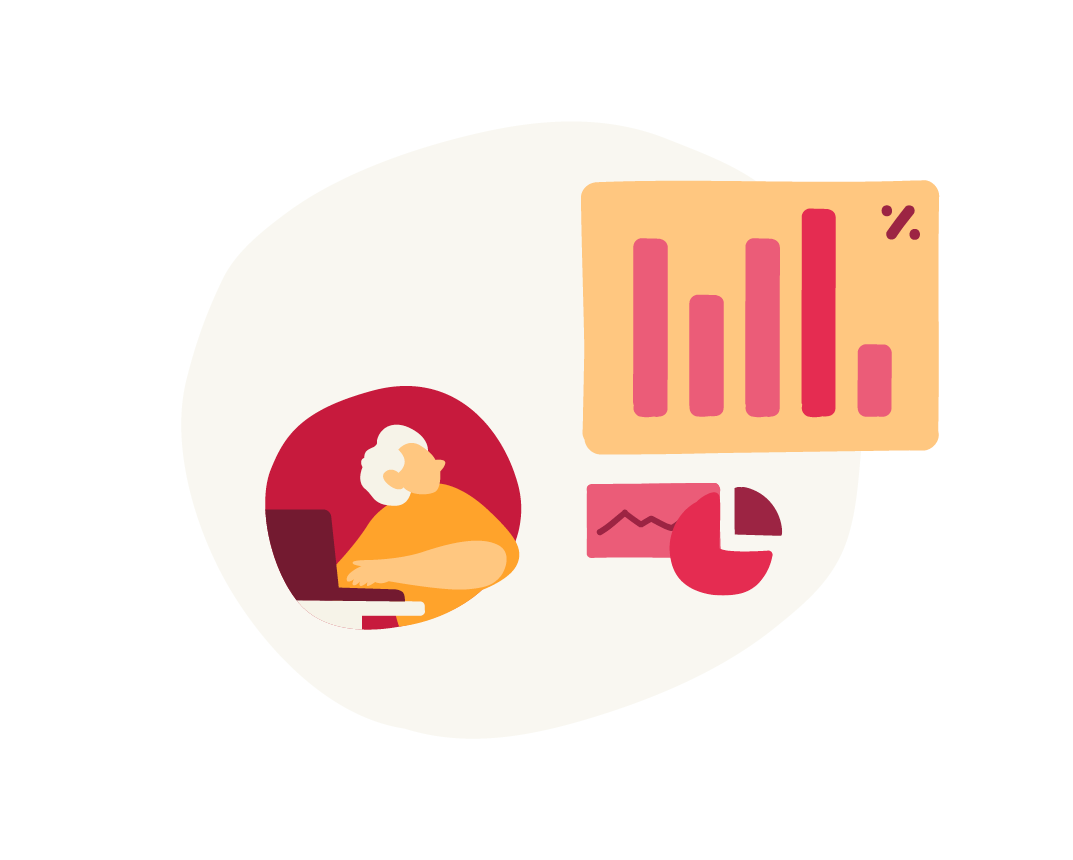
Measuring DEI&B takes quantitative and qualitative data
Measuring DEI&B may seem daunting, but it is certainly necessary. The Nova Collective, a firm that supports all areas of diversity, equity, and inclusion, spoke to Jeff Syroney, an independent market researcher. He specializes in measuring human emotions, experiences, and decisions. Syroney cites the value of both quantitative and qualitative measurements regarding DEI&B.
“Quantitative research is great to understand where, what, how many of a thing, whatever it is that you’re looking to understand. Qualitative research comes into play when you want to understand a more nuanced experience, or a process, or something that might involve deep emotions.
All qualitative research is directional—the results provide insight into new areas of discovery which might include additional questions, or confirmation or denial of hypotheses held. And then you can confirm with quantitative.”
In DEI&B work, you need both quantitative and qualitative data to understand and analyze where your organization’s strengths and opportunities exist. The key to metrics is looking at multiple quantitative and qualitative data points to get the whole DEI&B story, rather than just focusing on one measurement.
How to calculate and track important diversity and inclusion KPIs and metrics
In order to accurately gauge the success of DEI&B initiatives at your company, you need to know which metrics to track. Here are some different equity and inclusion metrics that can help you measure DEI&B at your organization.
1. Diversity across all levels of the organization
A logical place to start when it comes to measuring DEI&B is to look at demographics and representation at your company. This means calculating the diversity ratio or the percentage of people within specific groups within the organization, especially compared to market or industry benchmarks.
Although it’s important to have a big picture view of your organization, it’s equally essential to be aware of the details. While your company might be hitting desired representation benchmarks, it’s still possible for there to be an imbalance in certain functions, levels, and specialties. This is why including segmented data is also important.
As an example, let’s look at gender diversity. For instance, the ratio of woman:man founders in tech is 1:4.
To understand the gender breakdown of your team, it’s easiest to measure in ratio form. Using ratios will help you understand diversity (or the lack thereof) in your organization and within certain teams and rankings.
In contrast to gender diversity, the most effective way to measure age diversity is to measure against benchmarks. This will help you understand how you’re doing in relation to your industry and how you can improve.
Here’s how to calculate diversity percentage/ratio: Divide your people up into groups based on declared gender and then divide down to the smallest numbers.
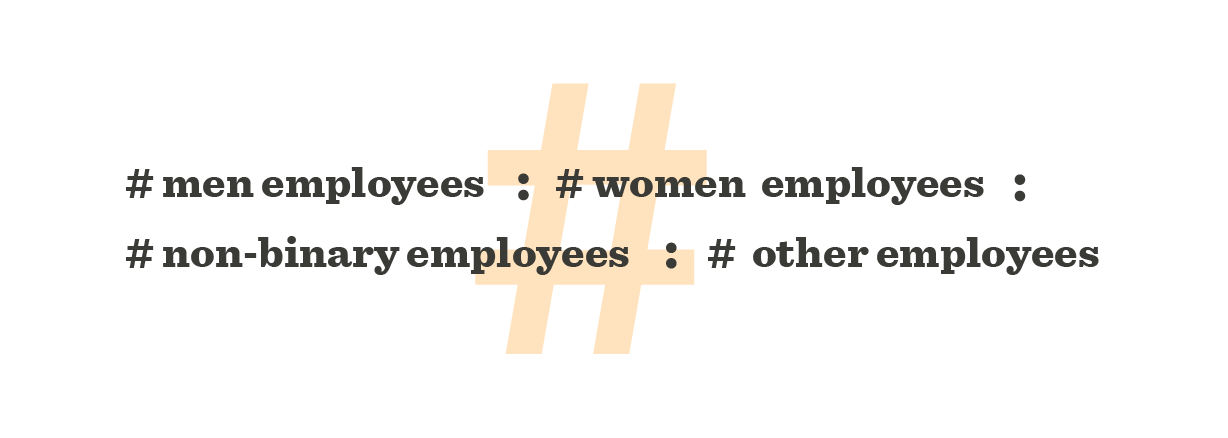
2. Candidate demographics
The type of candidates your organization attracts reflects quite a bit on your brand, your recruitment processes, and your perceived inclusivity. When you track your candidates’ demographics (with the number of candidates in each group represented as a percentage of total candidates), you can better gauge how you appeal (or not) to specific groups and if some groups are disproportionately represented across your organization.
3. Retention and turnover across employee groups
Your HR team is most likely already tracking retention and turnover data for general insights into the employee experience, but looking at this information as it pertains to certain minority groups can significantly illuminate the state of your DEI&B. If certain groups are more likely to leave the company than others, it can be a sign that the company is not meeting their needs.
The formula for calculating retention for a specific group would be:

The formula for calculating turnover is:
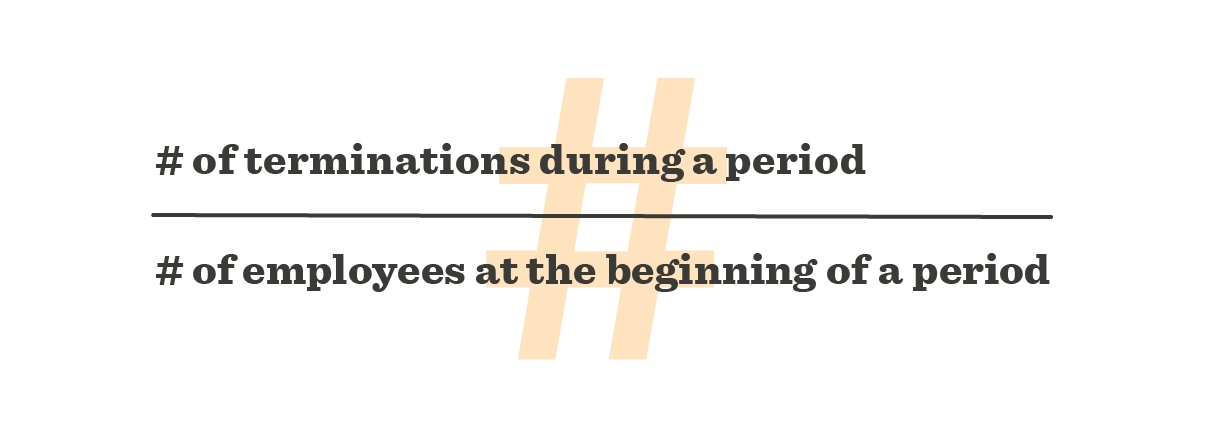
4. eNPS
Like retention and turnaround data, many HR teams already track their eNPS (employee net promoter score). By comparing eNPS figures between groups, you’ll be able to gather valuable insights into employee satisfaction among different demographics. If some employee groups are significantly less likely to recommend your company than others, it’s worth looking into this area for change and growth.
5. Adverse impact
Adverse impact is a DEI&B metric used to help you identify potential discriminatory practices at various stages of the employee lifecycle. Adverse impact uses the Four-Fifths rule, which states that “the selection rate of protected groups—which include race, sex, age (40 and over), religion, disability status, and veteran status—should be 80% or more of the selection rate of non-protected groups to avoid adverse impact against the former.”
Here is an example that shows how to calculate the likelihood of adverse impact on hiring:
- Calculate the selection rate for each group. The selection rate is the proportion of candidates or applicants who are promoted, hired, or otherwise selected. For each group, divide the number of applicants selected by the total number of applicants.
- Determine which group has the highest selection rate.
- Compare each group’s selection rate to the highest selection rate.
- If any group’s selection rate is less than 80 percent of the highest selection rate, it indicates adverse impact.
6. Advancement and promotion rate
Do certain groups of people have a lower or higher likelihood of advancing in your organization? You can look at this quantitatively by measuring the employee advancement and promotion rate.
The formula here is:
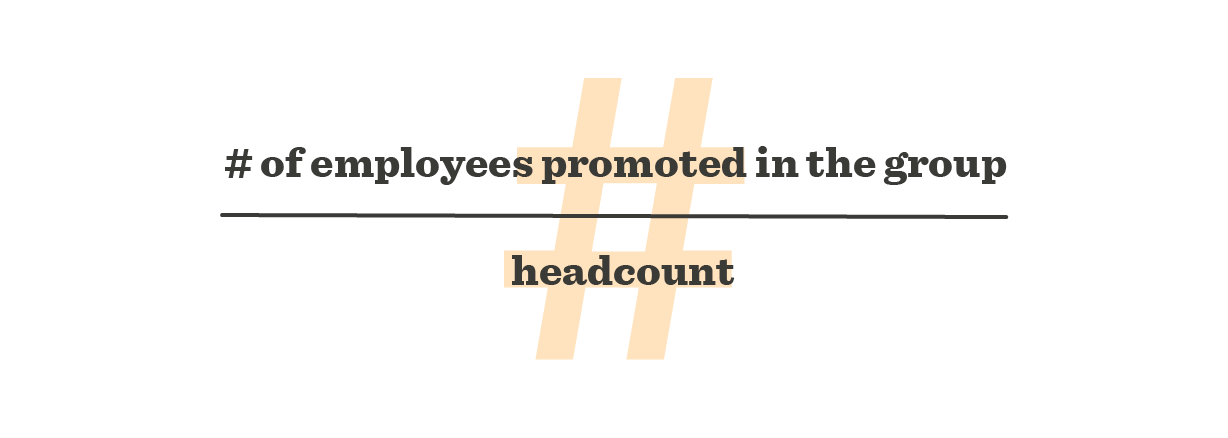
If you find that certain groups have lower promotion rates than others, it’s a strong sign of potential biases in your practices.
7. Pay equity
Women in the United States earn less than men. Gay and transgender people earn less than straight men. Black women earn less than white women.
To solve this problem, we need to understand how much of a discrepancy there is—and then put our money where our mouth is.
To calculate the pay gap, we need to compare the means of two different groups. For example, to measure the pay gap between men and women, use this formula:
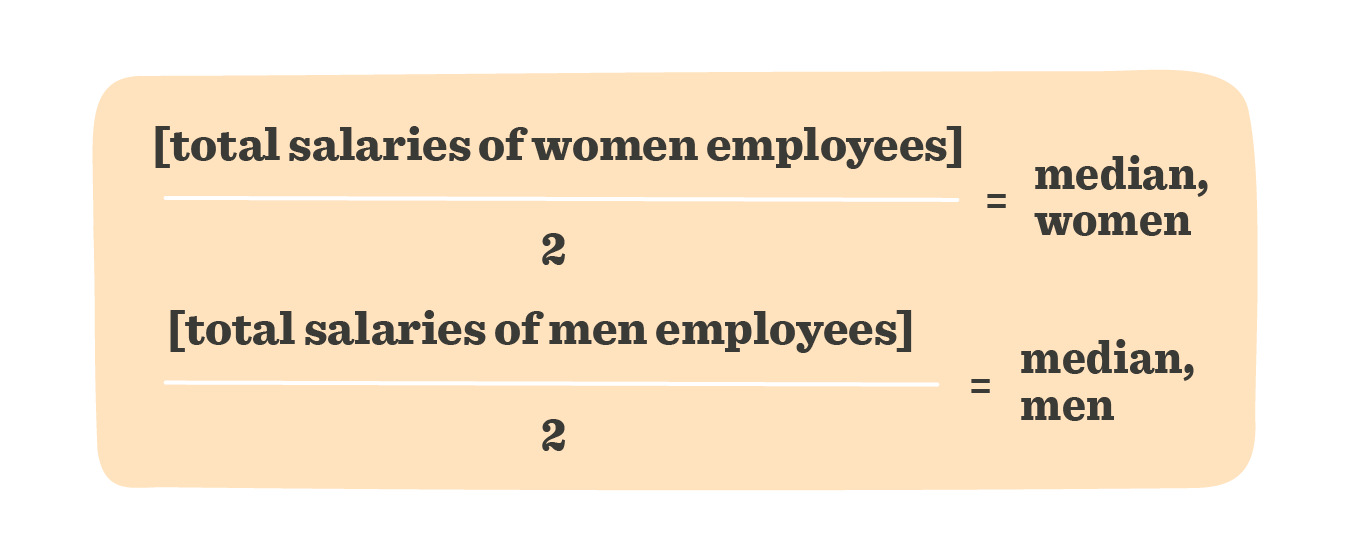
The pay gap is the difference between those two numbers, represented in percentage points. The current pay gap in tech between men and women in the United States is 3 percent.
With that data in hand, you can build a system that addresses existing inequities and prevents future missteps.
8. Employee resource group (ERG) participation
Employee resource groups, also called ERGs, are voluntary groups led by employees centered on shared life experiences, interests, or characteristics. They provide people of diverse backgrounds with the opportunity to form a community and create a sense of belonging within the organization.
Tracking the participation rate of your organization’s ERG groups can help point to how effective they are at creating a space that is welcoming to its target audience. If people are reluctant to join your ERGs, it’s worthwhile to investigate why.
9. Initiative-focused DEI&B metrics
Finally, tracking the metrics of any DEI&B-focused initiatives your organization creates is important. These can include recruitment programs at local, historically black colleges and universities or accelerated leadership programs for women. After all, you won’t be able to measure their success without looking at the numbers. You can make it easier on your future self by setting clear, measurable goals for these initiatives at the beginning. These goals will point you directly to which metrics to measure.
For example, you might measure:
- Promotion rates
- Net promoter score
- Number of participants in an event
- Number of new hires from the initiative
Establish a baseline with a pulse survey
For a combined quantitative/qualitative approach, the team at Gartner suggests a pulse survey to get a baseline and measure how an organization is doing. The responses will highlight what’s working and where to focus your efforts.
“With these survey results, leaders can create a baseline measure of employee perceptions and look for pockets of inconsistency, both in variability within teams or more broadly between parts of the organization,” the Gartner team writes in Harvard Business Review.

“They can also look at how demographics within their own workforce compare. While it’s always good news to have more positive perceptions, measuring consistency is also critical to determine whether the organization is inclusive throughout, or whether there are pockets of toxicity and exclusion hiding in the averages.”
To get the most out of any survey, ensure confidentiality and ask participants to rate their level of agreement with statements. You’ll also want to include some open-ended options for individuals’ qualitative feedback, but having the agreement scale will help you gather quantitative reactions to the same statements.
A word of caution, once you’ve collected survey data and are ready to analyze it, make sure your data truly represents the reality of your organization’s DEI&B situation.
“If the majority of your workforce holds dominant identities (e.g., white, male, straight, etc.), then averages are going to be misleading. You need to weigh survey responses to ensure all voices are represented,” according to Brynne Hovde, co-founder of The Nova Collective.
Gather additional qualitative data in focus groups
Once you have survey data, you may want to have listening sessions or focus groups to hear more about the high-scoring and low-scoring parts of the survey. People will appreciate the opportunity to share their professional experiences, and you’ll gain actionable insights.
Experts advise that people with training and development experience in your organization should handle focus groups. Especially with DEI&B topics, the conversations often become very personal. If a session isn’t facilitated well, it can create additional problems.
With a baseline of quantitative and qualitative data in hand, it’s time to slice and dice to gain the insights that will help you determine the next step for your DEI&B efforts.
Take action based on the DEI&B data you collect
Of course, simply collecting data and measuring DEI&B isn’t enough. Rather, it’s only the starting point. Once you’ve allowed the numbers to point you to areas that need improvement, it’s time to take real, meaningful action to improve your organization’s inclusivity. Below are some ways you can take DEI&B into account in various HR functions.
Candidate experience and recruiting
Analyze the data and employee feedback: How many diverse candidates are in your talent pool? If there’s room for growth, ask these follow-up questions to gather information.
- Do recruiters source talent from various organizations and platforms (e.g., historically Black colleges and universities)?
- Do job ads speak to a broad range of candidates?
- Is your screening process free from bias (e.g., is identifying data removed from resumes and applications)?
Hiring
Analyze the data and employee feedback: What percentage of the people you hire represent diversity? If there’s room for growth, ask these follow-up questions to gather information.
- Are hiring managers trained in how to avoid bias during interviews? Do the people you hire represent diverse workforce demographics (i.e., gender, ethnicity, age)?
- What’s the ratio of diverse candidates who accept vs. turn down your employment offers?
- How many diverse hires are being made across the organization (i.e., are there any disparities by function, level, or department)?
Development opportunities and promotions
Analyze the data and employee feedback: How do the number of development opportunities and promotions compare between your diverse and non-diverse employee population? If there’s room for growth, ask these follow-up questions to gather information.
- Are managers trained in how to coach and develop people?
- Are you using HR tech to review your internal talent pool for potential promotions and track the career path ratio?
- Does everyone have a professional development plan within your HRIS?
Finally, during exit interviews, ask people to share insights about their sense of belonging and inclusion. The ad-hoc feedback people provide in those interviews can provide insights on what’s working and what you should address regarding DEI&B.
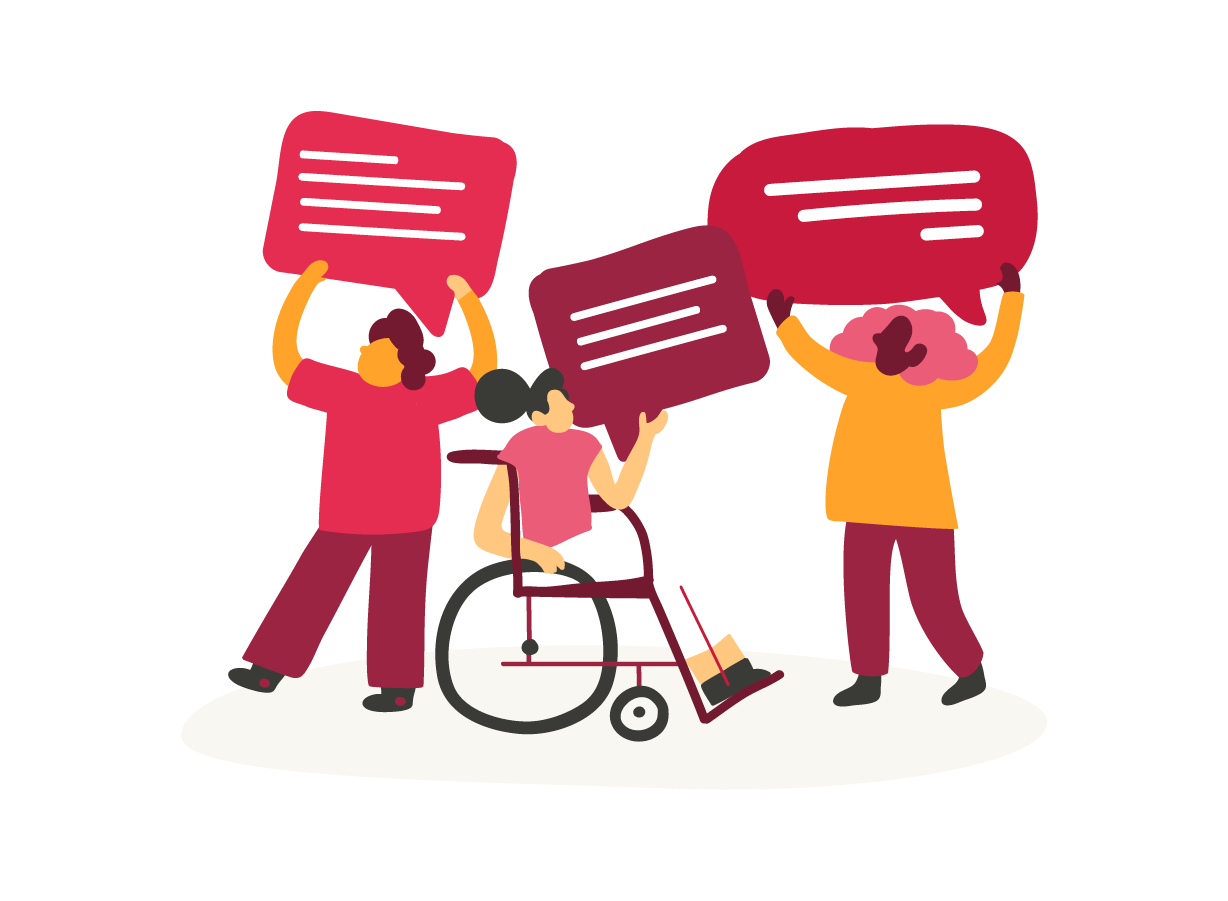
Embrace tech to support DEI&B within your company culture
When you’re faced with the massive importance and scale of DEI&B, making meaningful progress may seem daunting. Thankfully, there are tools that can help. An HRIS provides a powerful way to embed an appreciation for DEI&B within your organizational culture that goes beyond just gathering the metrics.
The Distrelec Group understands the challenge of making tangible progress regarding company culture and DEI&B. This leading European electronics, automation, and measurement technology distributor has 14 sites across Europe and works with over 1,000 industry-leading brands. COVID-19 became a catalyst for the HR team at Distrelec to change how they managed their approach to people.
They started by implementing Bob as their HRIS and a single source of truth for people data. Not only are they using Bob to capture standard information on their people, but they’re also using it to drive their efforts toward creating a more diverse, equitable, and inclusive workplace.
The equal opportunity section in Bob provides space for people to fill in various identifiers, including race, gender, and sexual orientation. The HR team can review and analyze KPI reports for various DEI&B initiatives. It’s about more than the numbers. The team at Distrelec can also incorporate what they learn about their people’s interests and hobbies to personalize rewards that “celebrate people for who they are at work.”
5 ways an HRIS can boost a sense of inclusion and belonging
- Collect information about hobbies and interests. Use it to personalize recognition.
- Customize and localize for each team member—by language, cultural practices, and relevant regulations.
- Analyze people data to identify gaps and bring about change.
- Adopt a global approach within the HRIS to support your multi-national teams.
- Empower people to connect about hobbies and areas of interest within the HRIS.

Recommended For Further Reading
Conclusion
Recent events around the world have clarified that DEI&B is not an isolated topic or something organizations should only address once a year in an annual workshop. Diversity, equity, and inclusion are essential to ongoing success.
Gartner’s research shows that organizations that confidently measure DEI&B, create accountability, and embed inclusion into talent decisions and processes report up to 20 percent more organizational inclusion than their peers without those approaches.
Even when you know that measuring diversity and inclusion and looking for ways to improve inclusion in an organization is necessary, it can still be challenging.
“D&I work is hard work. It pushes people, it makes people uncomfortable and, if you’re doing it right, it gets messy,” according to Brynne Hovde. “Trust in the process, and don’t shake up or abandon your strategy at the first sign of falling numbers. We always encourage D&I practitioners to make this clear to stakeholders from the beginning, so there are no surprises later.”
Indeed, there is significant work to be done in the areas of DEI&B. But, the effort is more than worth it. When you consider the critical dimensions of inclusion (fair treatment, integrating differences, decision making, psychological safety, trust, belonging, and diversity), the benefits of ensuring DEI&B in your organization are apparent.
Companies that embrace the challenge of making progress are poised to improve their results and elevate the employee experience. Without metrics and a baseline, organizations cannot understand if they’re making progress in this critical area. Measurement of DEI&B metrics demonstrates a significant commitment to creating lasting and definitive changes that will enhance the global outlook for professionals everywhere.
Meet Bob
At HiBob, we’ve built a modern HR platform designed for modern business needs—today and beyond.
We focused on building something robust yet intuitive and easy to use, which has led Bob to be the company culture platform of choice for thousands of fast-growing modern, mid-sized organizations.
For HR, it automates many common processes, allows greater oversight and visibility of the business, and centralizes all people data in a secure, user-friendly environment.
For managers, it provides access to data and insights to help them lead more effectively and streamline processes.
For employees, it’s the tools and information they need to connect, develop, and grow throughout their journey.
In a short time, Bob can be deployed to enable communication, collaboration, and connectivity that drives stronger engagement, productivity, and business outcomes.
